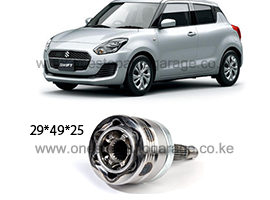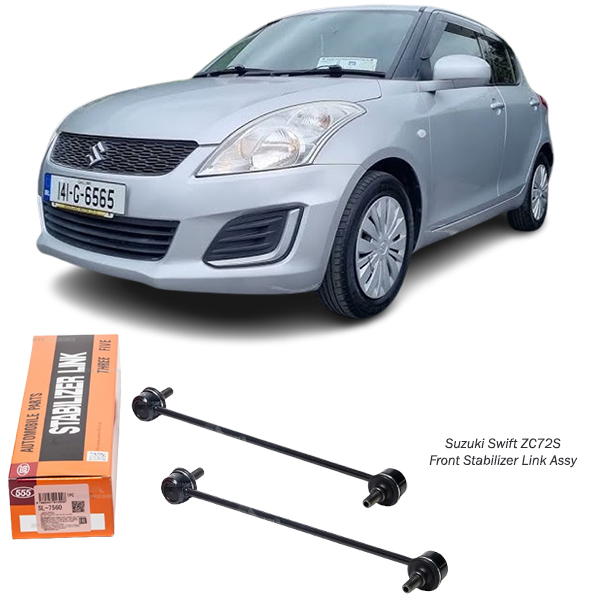-10%
Get Suzuki Swift ZC72S Front Stabilizer Link Assy SL-7560 in Kenya
A front stabilizer link assembly is a critical component in a vehicle’s suspension system, designed to enhance stability, reduce body roll, and improve handling during cornering or uneven road conditions. Its role in maintaining vehicle safety and driving comfort cannot be overstated. In this guide, we will explore the functions, benefits, design, maintenance, and replacement of front stabilizer link assemblies.
What is a Front Stabilizer Link Assembly?
A front stabilizer link assembly connects the stabilizer bar (also known as an anti-roll bar or sway bar) to the suspension components, usually the struts or control arms. The stabilizer bar reduces body roll by transferring force from one side of the suspension to the other during turns or while driving over uneven terrain.
The stabilizer link acts as a conduit, transferring forces from the wheels to the stabilizer bar, ensuring the suspension system operates effectively.
Components of a Front Stabilizer Link Assembly
- Rod or Shaft:
The main body of the stabilizer link, typically made of high-strength steel or aluminum for durability. - Ball Joints:
Located at either end of the link, these allow for flexible movement and ensure the link can adapt to changing suspension angles. - Bushings:
Rubber or polyurethane components that dampen vibrations and reduce wear by absorbing shocks. - Mounting Hardware:
Includes bolts, nuts, and washers to secure the link to the suspension system.
Functions of the Front Stabilizer Link Assembly
- Reduce Body Roll:
By connecting the stabilizer bar to the suspension, the stabilizer link helps minimize body lean during cornering, improving vehicle stability. - Enhance Handling:
It ensures the wheels maintain better contact with the road, providing improved steering response and handling. - Distribute Load Evenly:
The assembly helps balance the load across the suspension system, ensuring smoother operation. - Improve Ride Comfort:
By mitigating excessive sway and vibrations, the stabilizer link contributes to a more comfortable driving experience.
Types of Stabilizer Link Assemblies
- Fixed Length Stabilizer Links:
These links have a set length and are commonly used in standard passenger vehicles. - Adjustable Stabilizer Links:
Designed for performance or custom applications, these allow for length adjustments to accommodate suspension modifications. - Heavy-Duty Stabilizer Links:
Made for larger vehicles like trucks and SUVs, these links are more robust to handle heavier loads and rugged conditions.
Signs of a Worn-Out or Damaged Front Stabilizer Link Assembly
- Clunking or Knocking Sounds:
A damaged stabilizer link can produce noises when driving over bumps or uneven roads. - Excessive Body Roll:
If the vehicle leans excessively during turns, it may indicate a failing stabilizer link. - Steering Instability:
Difficulty maintaining a straight line or poor steering response can result from a compromised link. - Visible Wear or Damage:
Inspecting the stabilizer link may reveal broken ball joints, cracked bushings, or bent rods. - Uneven Tire Wear:
An imbalanced suspension system can cause irregular tire wear patterns.
Benefits of a Functional Front Stabilizer Link Assembly
- Improved Safety:
A stable suspension system reduces the risk of accidents by maintaining vehicle control during sharp turns or sudden maneuvers. - Enhanced Comfort:
Properly functioning stabilizer links minimize vibrations and sway, resulting in a smoother ride. - Extended Suspension Lifespan:
Stabilizer links help distribute forces evenly, reducing stress on other suspension components. - Better Tire Performance:
Balanced suspension improves tire contact with the road, promoting even wear and extending tire life. - Optimized Handling:
A stable and responsive suspension system ensures precise steering and control.
Installation and Maintenance of Front Stabilizer Link Assembly
Installation Process
- Raise the Vehicle:
Use a jack and jack stands to lift the front of the vehicle for easy access to the suspension components. - Remove the Old Link:
Unscrew the bolts securing the worn stabilizer link and remove it from the suspension. - Install the New Link:
Attach the new stabilizer link to the stabilizer bar and suspension components, tightening the bolts to the manufacturer’s torque specifications. - Check Alignment:
Ensure the new link is properly aligned and secured before lowering the vehicle. - Test Drive:
Drive the vehicle to confirm the suspension system operates smoothly without unusual noises or instability.
Maintenance Tips
- Regular Inspections: Periodically check the stabilizer link for wear, corrosion, or damage.
- Lubrication: Apply grease to the ball joints to reduce friction and extend their lifespan.
- Monitor Bushings: Replace worn or cracked bushings to maintain optimal performance.
- Replace in Pairs: To ensure balance, always replace stabilizer links on both sides simultaneously.
Replacement Interval for Front Stabilizer Link Assembly
The lifespan of a stabilizer link varies depending on driving conditions, road quality, and usage. On average, they may last between 50,000 to 100,000 kilometers. However, off-road driving or exposure to harsh environments may necessitate more frequent replacements.
Choosing the Right Stabilizer Link Assembly
- Vehicle Compatibility:
Ensure the stabilizer link matches the make, model, and year of your vehicle. - Material Quality:
Look for high-strength steel or aluminum constructions for durability. - Trusted Brands:
Opt for reputable manufacturers that meet OEM standards. - Warranty:
A good warranty indicates product reliability and quality. - Type of Link:
Choose between fixed or adjustable links based on your vehicle’s requirements.
Common Issues with Stabilizer Link Assemblies
- Corrosion:
Exposure to moisture and road salt can cause rust, weakening the link over time. - Loose Connections:
Improper installation or worn-out mounting hardware can result in loose stabilizer links. - Worn Bushings:
Aging bushings can crack or degrade, reducing their ability to absorb shocks. - Ball Joint Failure:
Excessive wear can cause the ball joints to lose flexibility, leading to poor suspension performance.
Environmental Impact
Old stabilizer links should be disposed of responsibly. Many automotive shops and recycling centers accept used metal components for proper recycling, reducing environmental waste.
Conclusion
The front stabilizer link assembly is an essential part of a vehicle’s suspension system, directly contributing to safety, handling, and ride comfort. Regular inspection, timely replacement, and using high-quality components are key to maintaining a stable and reliable suspension system.
Investing in a durable and compatible stabilizer link assembly not only enhances your vehicle’s performance but also ensures a safer and more enjoyable driving experience.
Follow us on Facebook for more parts.



